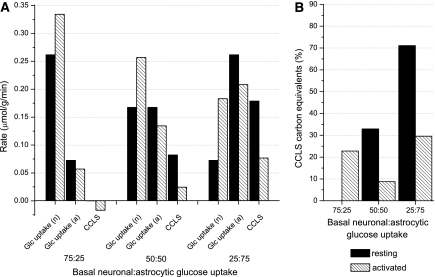Figure 1.
(A) Simulated rates of resting (solid bars) and activated (striped bars) substrate uptake in astrocytes and neurons, and contribution of cell-to-cell lactate shuttle (CCLS), for different conditions of basal neuronal: astrocytic glucose uptake. The suffix ‘a' or ‘n' stands for astrocytes or neurons, respectively. Here, by convention, we assume that if the lactate shuttle is from astrocytes to neurons (ANLS) the sign of the CCLS is positive, otherwise is negative. (B) Relative contribution of carbon equivalents derived from the CCLS compared with the total energy substrate flux in the specific cell compartment that is involved in lactate uptake (i.e., astrocytes in the 75:25 condition and neurons in the other conditions). In the 25:75 condition, the carbon equivalents derived from astrocytic lactate accounts for at most 30% of total neuronal energy substrates during activation, with the remaining coming directly from blood-borne glucose. In the condition of 75:25 neuronal versus astrocytic glucose uptake, the carbon equivalents derived from neuronal lactate accounts for ∼23% of total astrocytic energy substrates during activation. Note that the CCLS is neuronal–astrocyte lactate shuttle in the 75:25 condition, whereas it is ANLS in the other conditions. In addition, the bars are zero in the resting condition of the 75:25 case, as both neurons and astrocytes were found to export lactate in the interstitial space, and therefore no CCLS occurs between astrocytes and neurons. All simulations were performed using a 3:1 neuronal versus astrocytic stimulation ratio, and a 360-seconds stimulation (see DiNuzzo et al, 2010).

